Un-Impress
Curated by Rebecca Pristoop, Curator and Senior Program Manager at ArtBridge
On View from January 18 – March 17, 2024
Closing reception + Artists/ Curator Talk: Thursday, March 7, 6-8pm. RSVP HERE
Lower East Side Printshop is pleased to announce a group exhibition, Un-Impress, guest curated by Rebecca Pristoop. The exhibition will be on view from January 18th through March 17th with a reception on Thursday, January 18th, 6-8pm at the Printhsop.
To make a print is to make an impression. Through a process of transfer, images devised on one surface are impressed upon another. Similarly, people are impressed upon—whether through systems of thought, government, or family. Un-Impress presents seven artists who use printing processes to release the confines of the political, geographical, and ideological systems impressed upon them. Through research, self-reflection, and play, artists Paria Ahmadi, Tatiana Arocha, Lindsay Buchman, Nina Feigin, Juan Hernández Díaz, Qin Shen, and Linda Sok reveal alternatives to the structural imprints that have historically impacted their personal and cultural identities. Using varied methods of printing—including intaglio, relief, embossment, monoprint, screen-printing, and risograph—as well as weaving, painting, and assemblage, the artists in Un-Impress re-envision, re-order, or re-claim narratives of place, history, and family, offering impressions of their own.
 Tatiana Arocha, Creciendo desde mis raices, 2023
Tatiana Arocha, Creciendo desde mis raices, 2023
Tatiana Arocha’s contributions to Un-Impress, Creciendo desde mis raices (2023) El libro, la planta, las hojas, una memoria (2023-24), and Hojas en movimiento sobre el fuego (2023) speak to the eco/genocidal forces in the Colombian rainforest as it relates to the coca plant. Through colonization and resource extraction, the coca plant has been reduced to a commodified product associated with “the war on drugs.” Arocha, an immigrant from Colombia who moved to New York two decades ago, creates impressions—etchings and pigment prints—of the coca leaf to reclaim the plant as a sacred and multitudinous resource for the indigenous communities in the Andes and Amazonas. Chambira thread (made from the chambira palm native to the Amazon Rainforest), a vintage copy of Coca and Its Therapeutic Application by Angelo Mariani (who exploited the plant in the mid-19th century), copper plates, and pressed coca plant and leaves are incorporated into Arocha’s works.
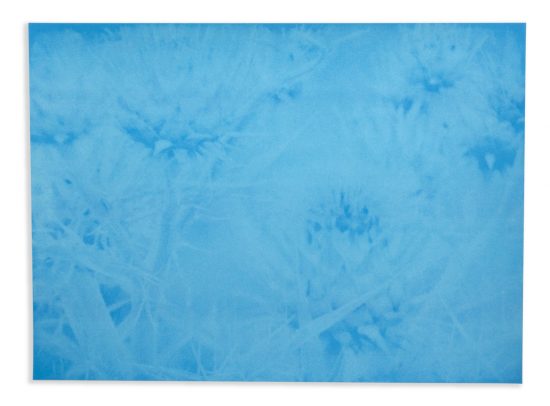 Lindsay Buchman, Everything I’ve Ever Loved (#4), 2023
Lindsay Buchman, Everything I’ve Ever Loved (#4), 2023
Lindsay Buchman also looks to a singular agricultural product, the orange, to unpack a narrative of production. For Buchman, tuning her eye to the cultivation of the orange is a means to examine a fraught history of racialized experiences in Orange County, CA, where she was raised as a mixed-race Chicana and transracial adoptee. Her screen print Stratagems (Orange Branch Containing Fruit), (2023) presents an archival image of a farmed orange tree dating to the 1940s and references the proliferation of citrus as the main crop of the region by the early 1900s, raising questions about agricultural labor and its prevalence to Mexican nationals. In concert with two screen prints with risograph additions, Everything I’ve Ever Loved (# 4 and #6) (both 2023), sourced from Super 8 film footage, this trio of works visualizes an ethereal sky and softly tinted blue landscape—a visual language situating home between positive affect and a backdrop of conditions contextualizing sociopolitical experiences through geography.
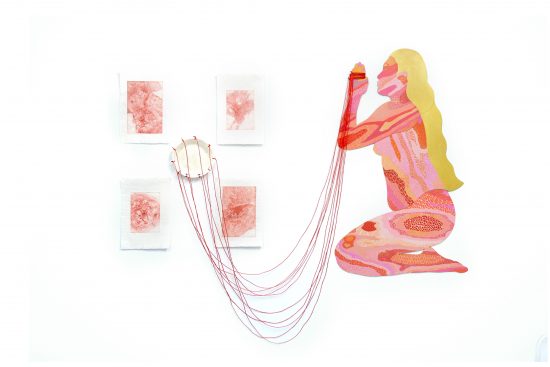 Qin Shen, The Prayer, 2023
Qin Shen, The Prayer, 2023
The blue hues of Buchman’s works gently converse with the soft pinks in Qin Shen’s intaglio prints from her installation, The Prayer (2023). Shen’s images appear abstract, yet there is a cellular quality to them, suggesting a connection to the body or organic matter. Shen’s prints trace the structure of fatty meats as a stand-in for female flesh. In relation to a painted self-portrait connected to these prints with a red thread, Shen confronts the familial and cultural expectations of femininity from her upbringing in Changshu, China. In an attempt to free her body and mind from these confines, Shen moved to Shanghai and then New York, enacting geographical transition as a means for self-definition. The impressions on Japanese paper that Shen produced, symbolize a transfer of power from an exterior set of conditions, to those inscribed from within.
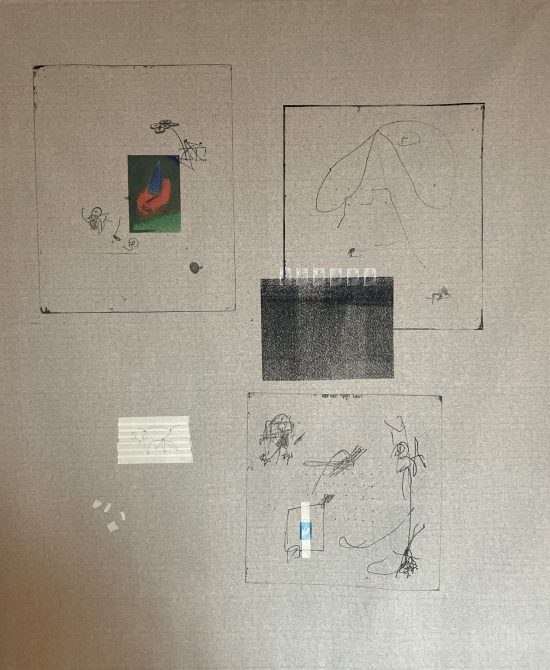 Paria Ahmadi, dots and boxes, 2023
Paria Ahmadi, dots and boxes, 2023
Paria Ahmadi also relocated her body to expand her practice. In her case, from Iran to New York. Playing with language and meaning, Ahmadi questions the narratives codifying borders and policy. Observing that systems are created through agreement, Ahmadi uses the materials of printmaking and sculpture to demonstrate how meaning can be created. By layering seemingly familiar images, objects, and words together, as she does in dots and boxes (2023), silkscreen on linen, 3 is a big number (2023), mixed media and coins, and letter from a tiny friend (2023), drawing, letterpress and inkjet on paper, the artist releases prescribed meanings of language to allow for a poetic interpretation that is personal, yet open.
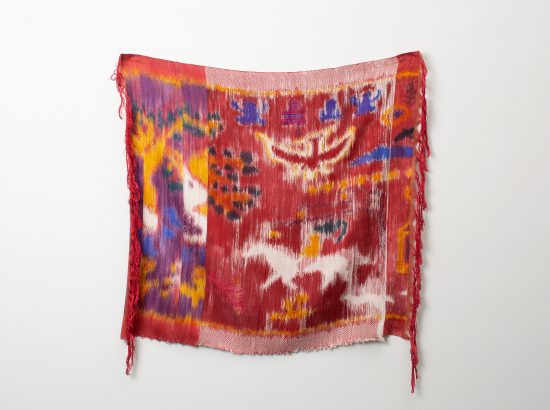 Linda Sok, Deities in Temples II, 2023
Linda Sok, Deities in Temples II, 2023
The theme of reinterpretation appears in the work Linda Sok and Nina Feigin as well. Both artists create prints that re-memorialize aspects of their lives. Sok, a second-generation descendant of survivors of the Khmer Rouge, was born in Australia to Cambodian parents. She has since lived in Boston, New York, and currently resides in Providence. Her continual crossing of borders and movement away from home sparked a longing for connection to her familial and cultural identity. Deities in Temples II (2023) was formed by weaving together images printed onto silk threads. The artwork is an amalgam of thoughts, interpretations, and impressions shared by family members in response to a description of a lost weaving once housed in the National Museum of Cambodia. Sok’s work is a practice of creation through many removes. It is a re-interpretation due to displacement of objects and people. Deities in Temples II manifests as a collective impression, visualizing something lost, yet proposing a potential future.
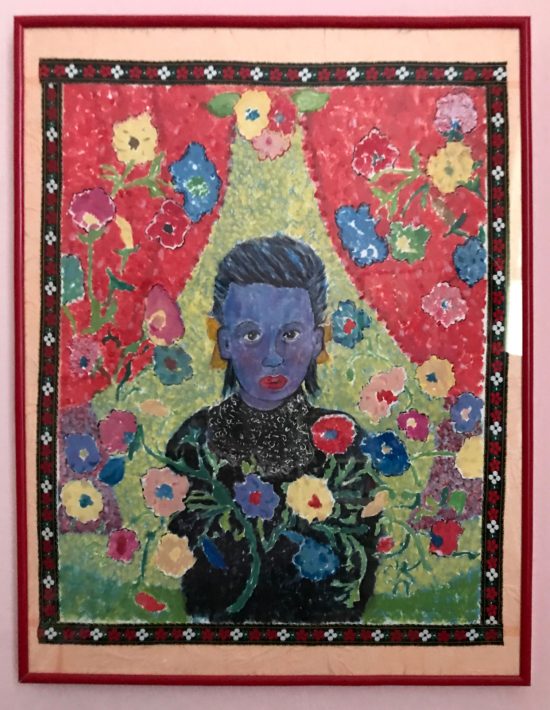 Nina Feigin, Remember Me, 2023
Nina Feigin, Remember Me, 2023
Nina Feigin re-memorializes herself in Remember Me (2023), a monoprint with ink and collage additions. Reflecting on a portrait of her as a child painted by the renowned American artist Alice Neel (1900–1984), Feigin created Remember Me as a reclamation of self. Neel’s portrait depicts Feigin as a young girl (c. 1952), presenting only her bust in front of a gray/blue background. Feigin is dressed in a white button down and has red ribbons in her hair. The young sitter stares blankly past the viewer. Feigin’s own self-portrait transfers the gray/blue of Neel’s background onto her skin and situates herself center stage, literally. Space is described as a theater with curtains flanking Feigin’s bust, the stage is flattened into a pastoral field. Flowers encircle Feigin and extend in front of the curtain, further collapsing dimensional space. In Feigin’s self-portrait, her stare remains blank, but the construction of the background provides the suggestion of a narrative beyond the empty scene offered in Neel’s portrait. While the story remains somewhat obtuse to the viewer, Remember Me honors Feigin’s relationship to her younger self.
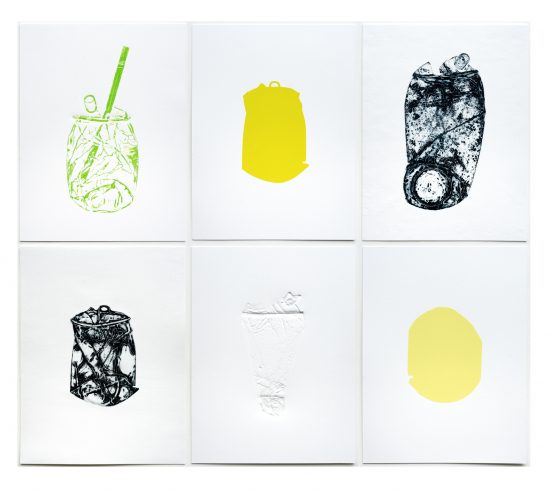 Juan Hernández Díaz, Defuncts (detail), 2023
Juan Hernández Díaz, Defuncts (detail), 2023
Juan Hernández Díaz’s Defuncts (2023) amass as a conceptual counterpoint to the works presented in Un-Impress. A selection of prints made through embossment, intaglio, relief, and screen-printing, Díaz has constructed a grid of impressions that create order out of disorder. Using the imprints of 15 different metal cans gathered from random locations in Hamilton Heights, Defuncts is an attempt to ground the artist in place, perhaps even map his territory, as he travels between the United States and Colombia while securing his U.S. visa. Each print measures 8 ¾ x 11 ½ inches. Arranged together, Diaz’s installation defines a system and suggests a desire to create boundaries while navigating borders.
Through various printmaking processes, the artists in Un-Impress inscribe alternatives to the dominant systems directing the political, geographical, ideological, or familial narratives that have impacted their personal and cultural identities. As viewers of the exhibition, complete with the spongy mass of our brains and the internal perceptions of our soma, we will undoubtedly leave with imprints of the artworks in our own systems. A question to viewers is thus put forth: What impressions will remain with us, and what might we be prompted to un-impress, for the sake of our own narratives?
About the curator
Rebecca Pristoop is a curator, performance artist, and art educator. She is currently Curator and Senior Program Manager at ArtBridge where she facilitates socially engaged art making between artists and public housing residents, and a curator with COLLECTIVE_VIEW, a group of female identified art professionals based in New York. Rebecca has contributed to and curated exhibitions at MoMA, The Jewish Museum, The Tang Teach Museum, and other prestigious institutions. She received an MA in art history from New York University’s Institute of Fine Arts, and a BA in art history and dance from Skidmore College.
###
Lower East Side Printshop’s programs have been supported in part by public funds from the National Endowment for the Arts, New York State Council on the Arts with the support of Governor Kathy Hochul and the New York State Legislature, and the New York City Department of Cultural Affairs in partnership with the City Council. Private supporters have included: Lily Auchincloss Foundation, Milton and Sally Avery Arts Foundation, Jerome Foundation, New York Community Trust, Paul Bechtner Foundation, Leon Polk Smith Foundation, and PECO Foundation.
We thank our volunteers, friends, members, and patrons for their dedication, support, and generosity.